Why you can trust Tom's Hardware
Comparison Products for Samsung 980 500GB
Today, we compare the Samsung 980 against some of the best SSDs available. This includes the Samsung 980 Pro, 970 EVO Plus, SK hynix Gold P31, and Seagate BarraCuda 510. We also threw in a WD Blue SN550, Crucial P1, and P2 into the mix for good measure.
Game Scene Loading - Final Fantasy XIV
Final Fantasy XIV Shadowbringers is a free real-world game benchmark that easily and accurately compares game load times without the inaccuracy of using a stopwatch.
With a total load time of 9.62 seconds, the Samsung 980 is just as fast as the Pro model in this benchmark. It also led the WD Blue SN550 by half a second and left the Crucial P2 in the dust.
Transfer Rates – DiskBench
We use the DiskBench storage benchmarking tool to test file transfer performance with a custom dataset. We copy a 50GB dataset, including 31,227 files of various types, like pictures, PDFs, and videos, to a new folder and then follow-up with a reading test of a newly-written 6.5GB zip file.


With a score second only to the Samsung 980 Pro, the 980 proves capable of handling moderate copies with ease. It falls behind its DRAM-based competition in reading back the large .zip file, however, due to its DRAM-less, 4-channel design.
Trace Testing – PCMark 10 Storage Test
PCMark 10 is a trace-based benchmark that uses a wide-ranging set of real-world traces from popular applications and everyday tasks to measure the performance of storage devices. The quick benchmark is more relatable to those who use their PCs for leisure or basic office work, while the full benchmark relates more to power users.

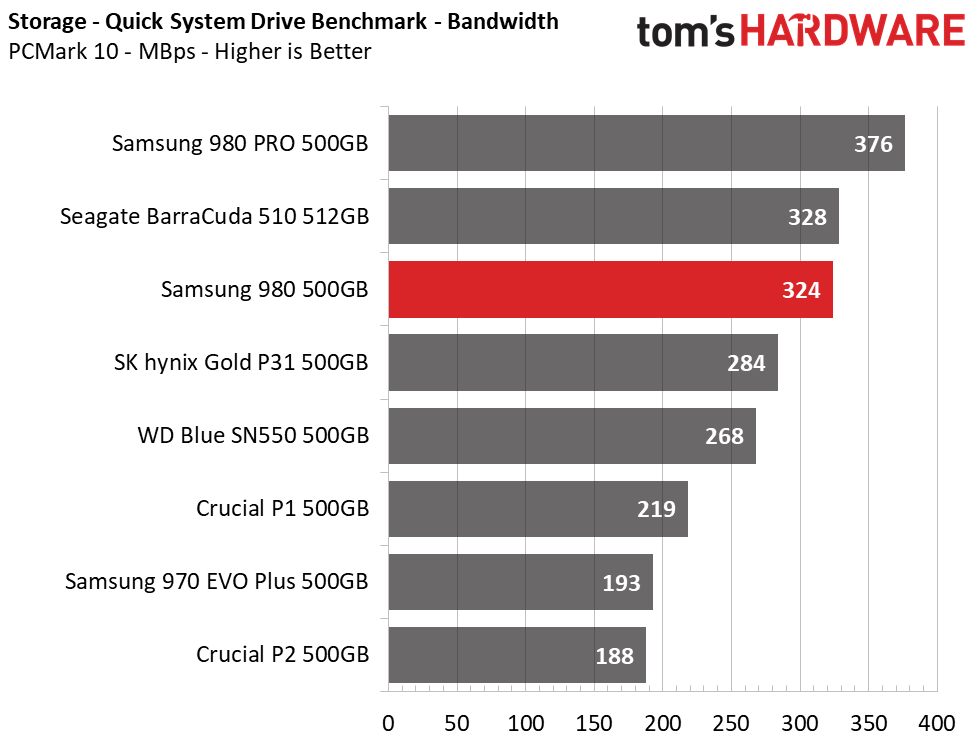




Although its large file read performance wasn’t quite as fast as its DRAM-based competition, the Samsung 980 delivered very good PCMark 10 scores. Placing third place in both the Quick and Full System Drive benchmarks, the Samsung 980 proves a responsive pick for those using the SSD as their daily driver.
Get Tom's Hardware's best news and in-depth reviews, straight to your inbox.
Synthetic Testing - ATTO / iometer
iometer is an advanced and highly-configurable storage benchmarking tool while ATTO is a simple and free application that SSD vendors commonly use to assign sequential performance specifications to their products. Both of these tools give us insight into how the device handles different file sizes.




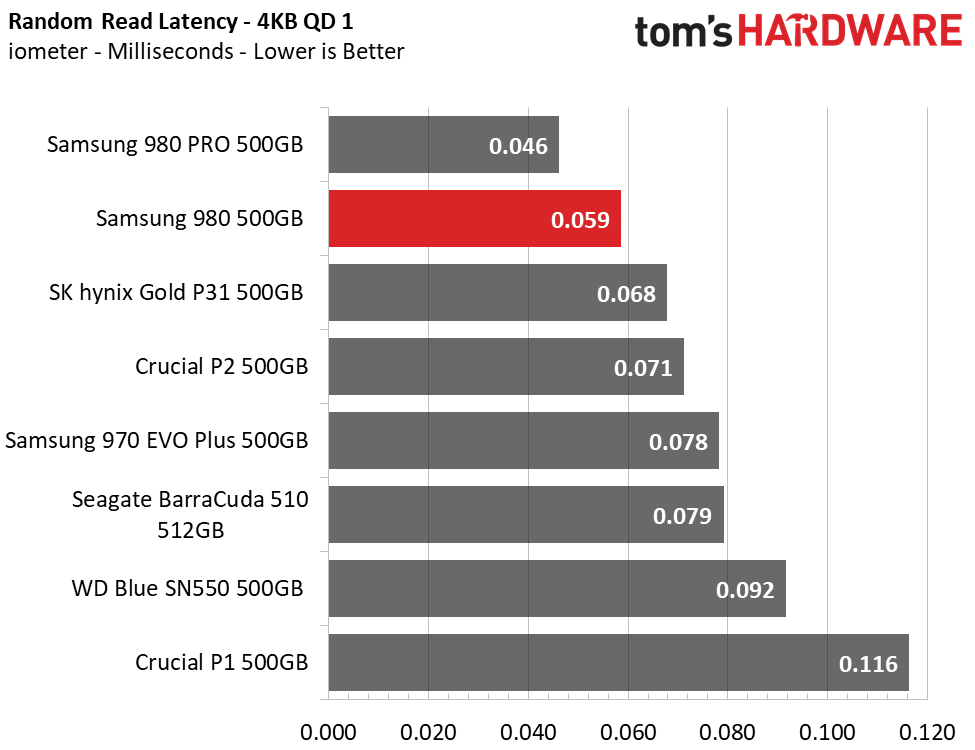


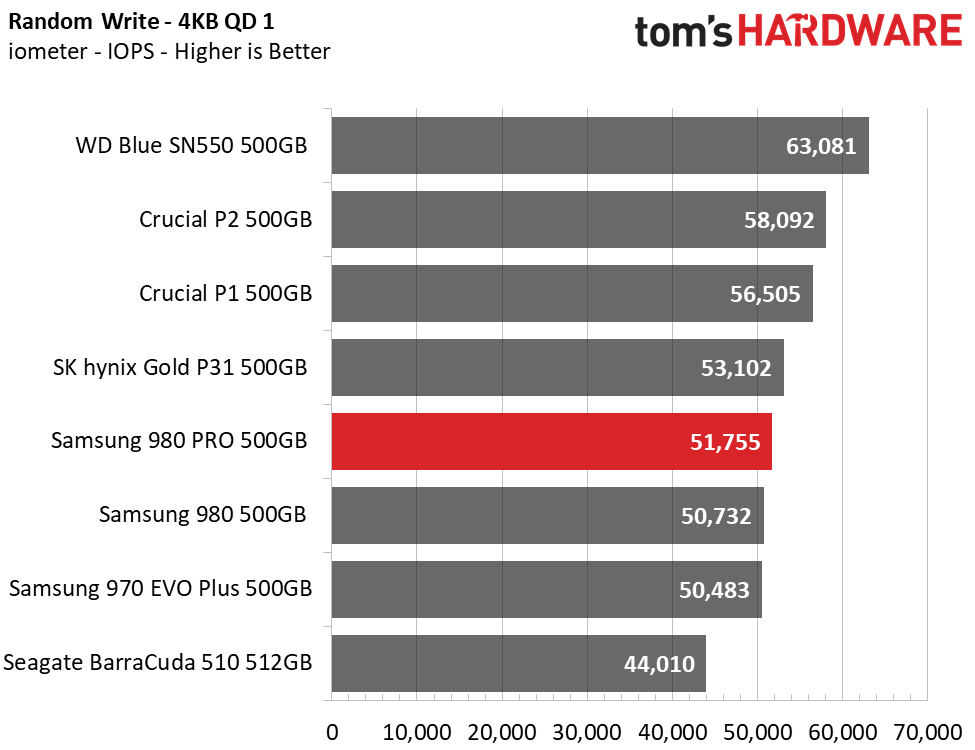
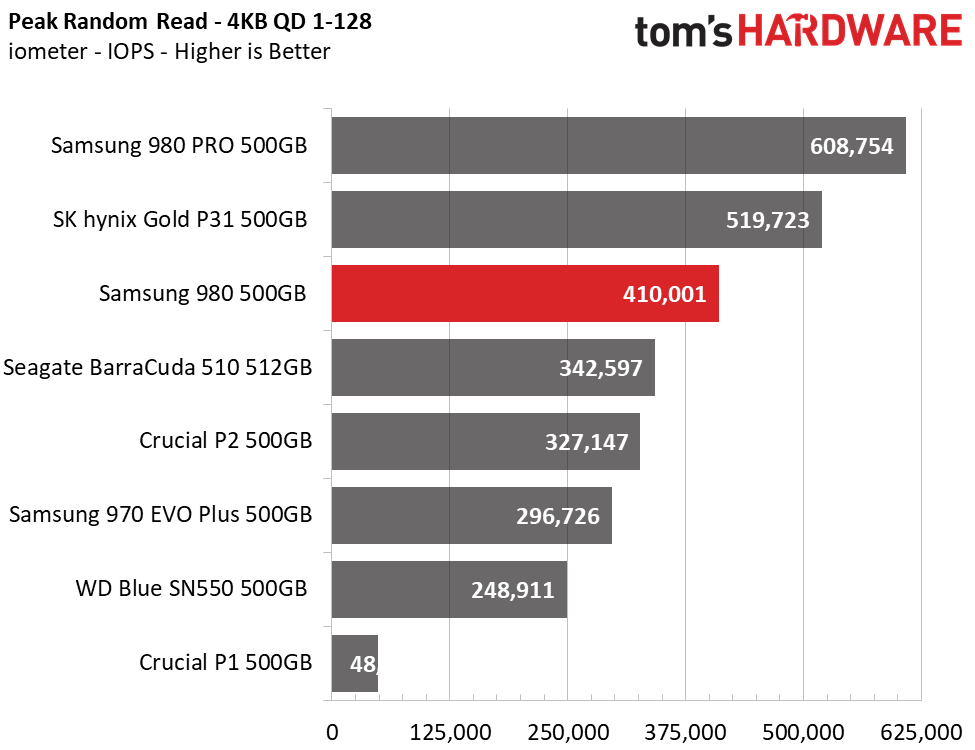
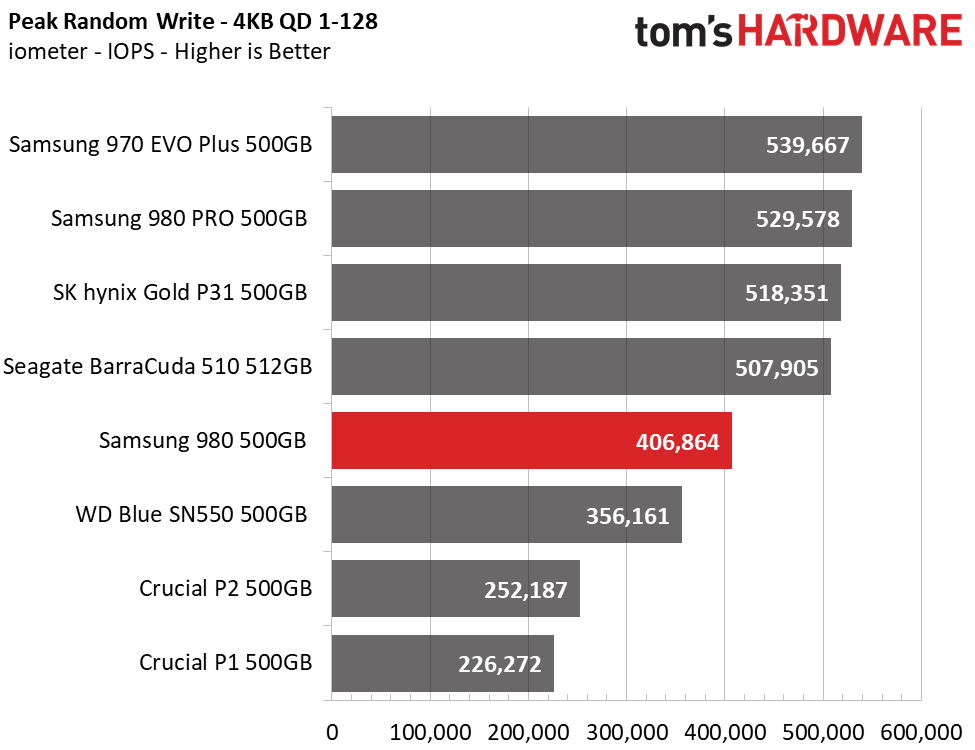
Sequential read performance is not quite as fast as its DRAM-based competition, especially at 128KB-2MB block sizes, but its write performance is solid across all block sizes. Samsung’s 980 achieved 3.2 / 2.3 GBps in peak sequential performance and achieved very respectable random speeds. With a read latency of just 0.059 milliseconds, it is one of the fastest random reading NVMe SSDs we have tested at a QD of 1. Even when scaling the QD up, the 980 delivers respectable peak random IOPS, too.
Sustained Write Performance and Cache Recovery
Official write specifications are only part of the performance picture. Most SSDs implement a write cache, a fast area of (usually) pseudo-SLC programmed flash that absorbs incoming data. Sustained write speeds can suffer tremendously once the workload spills outside of the cache and into the "native" TLC or QLC flash. We use iometer to hammer the SSD with sequential writes for 15 minutes to measure both the size of the write cache and performance after the cache is saturated. We also monitor cache recovery via multiple idle rounds.





Samsung’s 980 Pro absorbed roughly 100GB of data before degrading from an average write speed of 2.5 GBps to an average rate of 315 MBps for the remainder of the test. It lags most SSDs overall, but it is tuned for consumer burst-type workloads more than sustained writes anyway. It also recovered roughly 30GB of cache space within one minute of idle time. For most workloads, the write performance should be sufficient and the cache will recover fairly quickly for responsive performance.
Power Consumption and Temperature
We use the Quarch HD Programmable Power Module to gain a deeper understanding of power characteristics. Idle power consumption is an important aspect to consider, especially if you're looking for a laptop upgrade. Some SSDs can consume watts of power at idle, while better-suited ones sip just milliwatts. Average workload power consumption and max consumption are two other aspects of power consumption, but performance-per-watt is more important. A drive might consume more power during any given workload, but accomplishing a task faster allows the drive to drop into an idle state more quickly, ultimately saving energy.
We also monitor the drive’s temperature via the S.M.A.R.T. data and an IR thermometer to see when (or if) thermal throttling kicks in and how it impacts performance. Bear in mind that results will vary based on the workload and ambient air temperature.

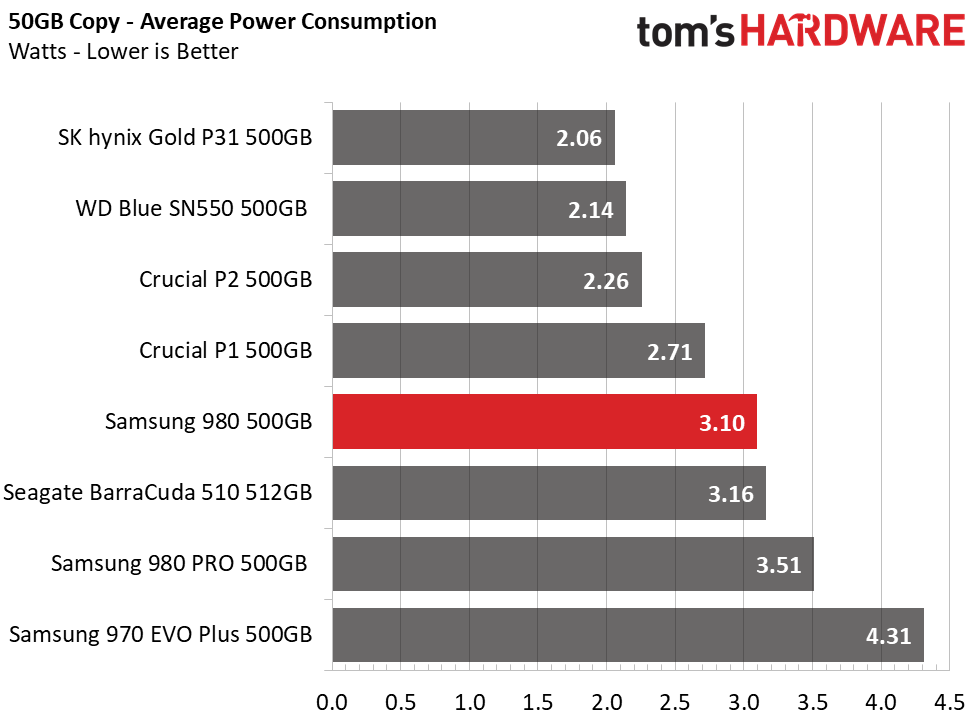

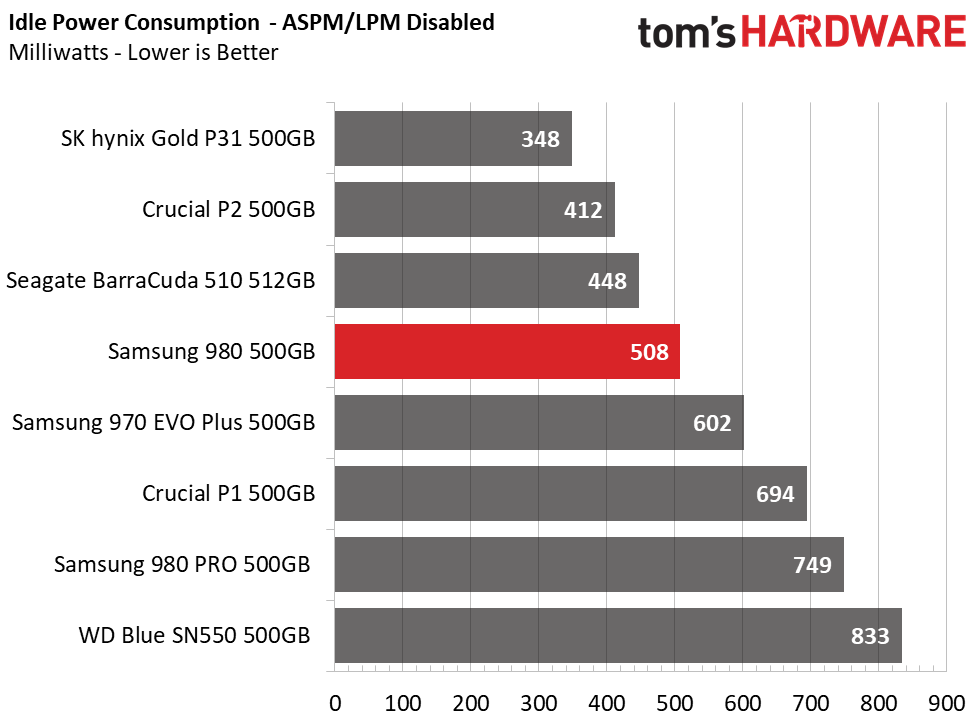
Although not quite as efficient as SK hynix’s Gold P31, Samsung’s 980 still delivers very good efficiency scores under load. On average, the Samsung 980 consumed just 3.1W and peaked at roughly 4.3W. Idle power consumption was low, even with ASPM disabled in the UEFI. At idle, the 980’s controller temperature hovered around 40 degrees Celsius and after writing 300GB of data without throttling, the SSD’s controller reported a max temperature of 70 degrees Celsius in a room with an ambient temperature of 24 degrees.
MORE: Best SSDs
MORE: How We Test HDDs And SSDs
MORE: All SSD Content
Current page: 500 GB Performance Results
Prev Page Features and Specifications Next Page 1TB Performance Results and Conclusion
Sean is a Contributing Editor at Tom’s Hardware US, covering storage hardware.
-
HideOut I have to agree with Hotaru, this "inexpensive" as you call it isnt. Also, How is it that its read IOPS is 3x slower than its write?Reply -
magbarn SK Hynix was the underrated NVME value of 2020.....Reply
Would prefer that drive over the 980 any day. -
Krotow Thanks about the review. Will help to warn people who are searching for 980 Pro drive about avoiding this curiosity.Reply -
atomicWAR Its to bad they didn't make a 2TB model. These would be great for budget NVMe game drive.Reply -
escksu Its not that cheap..... But still decent. Performance wise, its fine.Reply
Many people thought that you need to fastest drive and PCIE 4.0 ones will be much faster. All the 5000-7000MB/s are just sequential transfers on benchmarks, you will not be able to hit such speeds in reality. -
TCA_ChinChin This is still pretty expensive for a dram-less drive, no matter how much software Samsung packs to increase performance.Reply -
ukanio Change MLC to TLC is a big mistake, endurance is low and disk slow down after fill witch data. It's 980 EVO, PRO stop to exists on 970. Shame on samsung! How dare you!Reply

